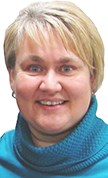My husband and I lost a good friend on May 17. Her name was Laurie and she was one of the most special people I’ve had the good fortune to know.
We shared in every major and minor event in our lives: birthdays, jobs, weddings, baptisms, games weekends, movie marathons, Christmas, and one of my favorite — a graduation party we surprised her with when she became a registered nurse.
Laurie laughed freely and loved fully, and even though we lived more than two hours apart, we were together often and have an amazing storehouse of memories built on a friendship we treasured.
The news that she was gone hit us hard. She had been battling an illness for a few years but I guess we expected she would bounce back, since she’d done so before. Her death wasn’t COVID-19 related, but the marking of it certainly was. There were no gatherings over 10 at that time so no funeral to attend. No chance to hug her sisters. No opportunity to grieve together.
Then our pastors stepped in and suggested we have a memorial service. With their kind and caring presence we gathered in our backyard; 10 people, and others on Facetime, to hear words of comfort and strength, and to share in the experience of grieving someone we loved. There were tears and there was laughter—just like you might expect—on the beautiful afternoon in May when she was remembered.
A few summers ago a trip to South Dakota took my family to the town of De Smet, the setting of several of the Little House books by Laura Ingalls Wilder. You can wander the homestead, tour the house that Pa built in town, and look through items belonging to each member of the family. You can also visit the cemetery where several of the Ingalls' family are buried. A chain link fence cordons off their graves where you will find fresh flowers and handwritten notes left by tourists who felt compelled to mark the moment.
A glance at nearby plots reveals names readers of the books would remember, but others that were unfamiliar. Yet chances are their stories would have been remarkably similar to those whose names we knew. Pioneering families that lived in the same area. They too would have settled the land, planted crops, built homes, started families, fought fires, experienced droughts, and worked to secure education for their children. Perhaps their stories weren't recorded and handed down – but then again maybe they were.
The stories shared at kitchen tables, family gatherings, and yes, funerals, are the source of inspiration, generational awareness, folklore and humour; and it helps put personality and legacy to what otherwise would be known only as numbers: the number of settlers in a given area, the tally of those ill with various diseases, or even the number that died while establishing a homestead.
Somewhere, in a lab or office setting, Laurie's information will be added to the cumulative total of Canadians who have died from kidney disease this year. Her death will become part of a bigger collection of data for funding and research. Those numbers tell an overall story of its prevalence across our nation, but say nothing of the individuals whose life was so much more than their cause of death.
It's easy to get lost in the numbers. But whether it’s hunger or heart attacks; disaster or dislocation, cancer or COVID-19, those we have lost are so much more than the diagnosis and the data. They deserve to be remembered and their stories have to be told. We need the opportunity to express what it means to have a Laurie in our lives. That's my outlook.



